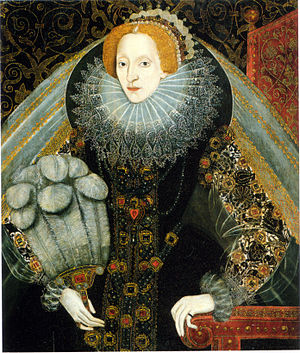
Back بورتريه إليزابيث الأولى Arabic Retrats d'Elisabet I d'Anglaterra Catalan Retratos de Isabel I de Inglaterra Spanish Elisabet I av England i porträttkonsten Swedish


The portraiture of Queen Elizabeth I (1533–1603) spans the evolution of English royal portraits in the early modern period (1400/1500-1800), from the earliest representations of simple likenesses to the later complex imagery used to convey the power and aspirations of the state, as well as of the monarch at its head.
Even the earliest portraits of Elizabeth I contain symbolic objects such as roses and prayer books that would have carried meaning to viewers of her day. Later portraits of Elizabeth layer the iconography of empire—globes, crowns, swords and columns—and representations of virginity and purity, such as moons and pearls, with classical allusions, to present a complex "story" that conveyed to Elizabethan era viewers the majesty and significance of the 'Virgin Queen'.
- ^ Arnold 1978